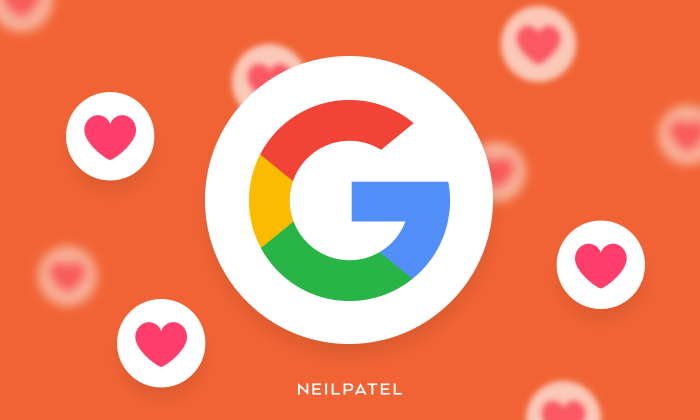
User signals!
It’s the one thing SEOs don’t optimize for.
I don’t know why most SEOs ignore this metric considering how important it is to Google.
See, Google doesn’t care to put the website with the most backlinks at the top or the best on page SEO… they want to put the website that you and other people love at the top.
That’s why they look at user signals.
Now, if you aren’t familiar with user signals, check out this experiment by Rand Fishkin that I discussed in a recent article.
It shows that if everyone performed a Google search and clicked on the 4th listing instead of the first one, the 4th skyrockets to the top spot almost instantly.
I’m not saying you should tell your users to click on your listings over the competition. Instead, you should focus on the user. Because if you can make users love your site, then you will rank higher over time.
So, my team and I thought it would be fun to look at the Google Analytics accounts of websites that have never been impacted negatively from a Google algorithm update to see what type of sites Google loves to rank (and their user signals).
By looking at metrics related to the user such as bounce rate, time on site, pageviews per visitors (and 5 other signals), we were able to come up with benchmarks that you should aim for.
We ended up analyzing 518 sites. But before we go into our findings, here are some notes about the data:
- Each website had to have been around for at least 3 years. We didn’t look at any brand new websites because they wouldn’t have been around long enough to figure out if Google loved or hated them.
- Each website had at least 5,000 monthly visitors a month from Google.
- We excluded sites there were in Alexa’s top 1,000 list. Plus we didn’t really have any data we could share from any of those sites.
- We exclude any company that was generating over $100,000,000 in revenue. I know that seems high, but we needed a ceiling. When you start looking at data from extremely popular companies, it really skews the data.
- We bucketed sites into 10 different categories and we looked at both B2B and B2C sites.
- All of the data was gathered using Google Analytics and Google Search Console.
Let’s start.
User signal #1: Bounce rate
You’ve heard the term bounce rate before. And you know that you want to get it as low as possible. But before I get into that, let’s break down the definition:
The percentage of visitors to a particular website who navigate away from the site after viewing only one page.
We found that Google loves sites that have a bounce rate between 26% and 69%:
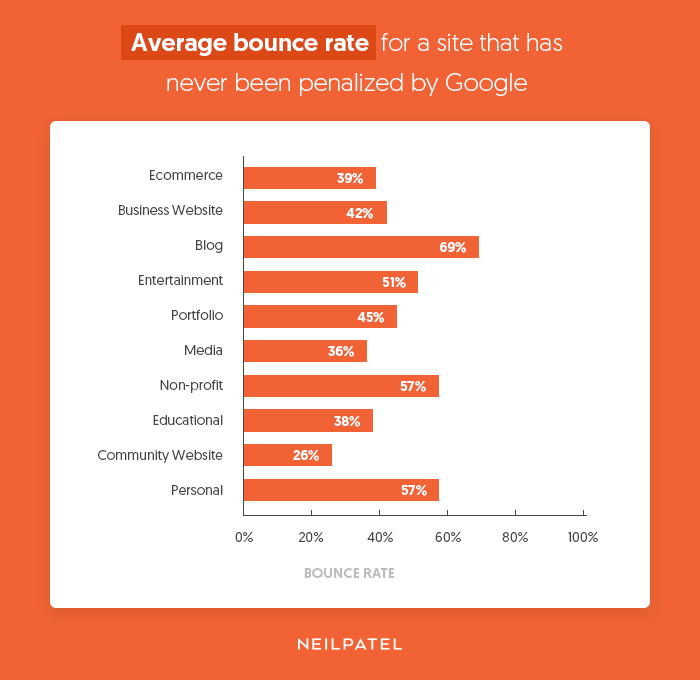
Based on the type of site you have, you should aim to have a bounce rate as close to (if not better than) the sites above.
If you have a bounce rate that is higher, just follow these 13 steps to help reduce it.
User signal #2: Mobile friendliness
Roughly 60% of all searches take place on a mobile device.
Because more people search Google using a mobile device and due to the fact that they have a mobile-first index, we thought it would be wise to see if sites that are in the good graces of Google have a mobile-friendly site.
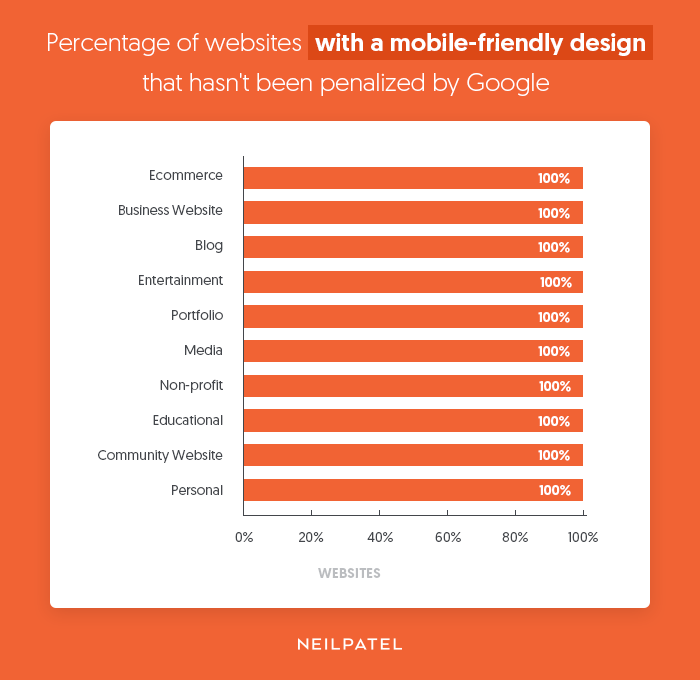
As you can see, all 518 sites had a mobile-friendly site. In almost all cases, they didn’t have a “separate” site just for mobile, instead, their website was responsive.
This also makes sense because these days you have to think mobile first when you are designing or creating any website.
If your website isn’t responsive, you should get that fixed ASAP.
And I know some of you are probably wondering about AMP. Most of the sites we looked at were not leveraging the AMP framework as they weren’t all blogs.
User signal #3: Average load time
This is the only metric we didn’t leverage from Google Analytics or Search Console. Instead, we ran each website through Pingdom.
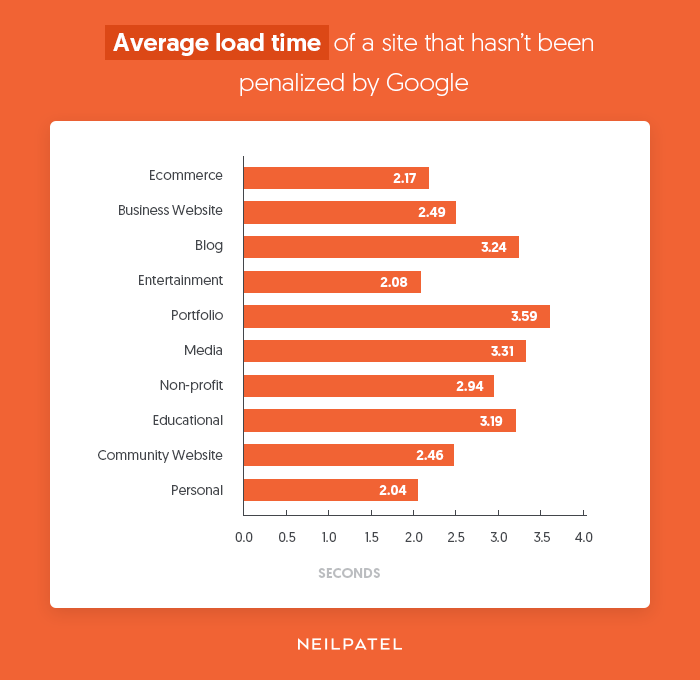
In general, the faster your website loads the better off you are. Why would you want people to have to wait 5 or 10 seconds for your site to load? I know I don’t like waiting.
Google not only uses it as a factor within their algorithm but the slower your site loads the fewer sales you will generate.
If an e-commerce site is making $100,000 per day, a second in load time delay will roughly cost you $2.5 million in lost sales each year.
If you want to improve your load time in the eyes of Google, check out this Page Speed Insights tool that they have. It breaks down exactly what you need to fix.
Don’t worry about getting a perfect score, just get as high as possible.
User signal #4: Percentage of repeat visitors
No one really knows the exact factors Google uses in their algorithm.
And no one has proof if Google is using data from Google Analytics, Chrome, or toolbars (as far as I know). But if I had to guess, I would say there is a high chance they are assuming it is legal.
One of the signals I would look at is repeat visitors. The fact that someone keeps going back to a website tells Google that it has loyalty and people love it.
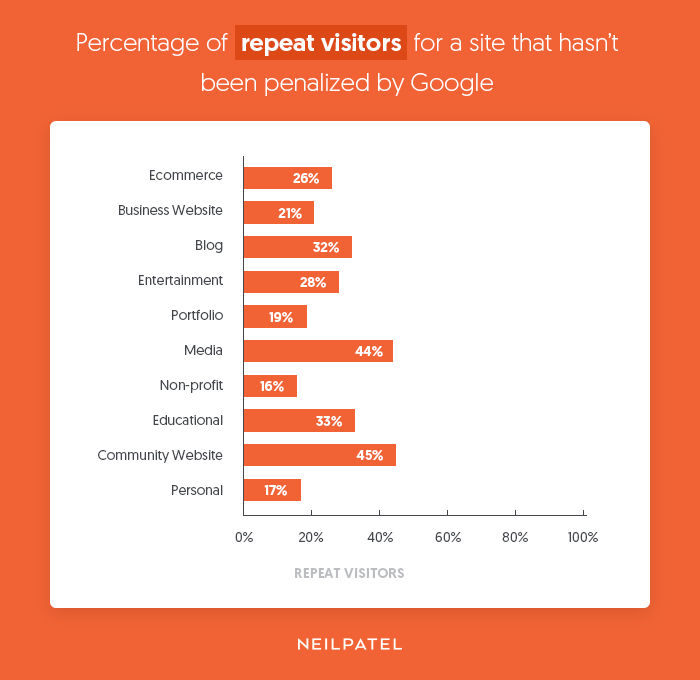
As you can see from the graph above, websites that have done well on Google have anywhere from 16% to 45% repeat visitors.
When you are starting off, your repeat visitor count is going to be extremely high because it’s going to be you and your friends continually going back to your site.
But as you grow, you’ll notice that it will drop to less than 10%. To get visitors continually coming back to your website, you’ll want to use tools like Subscribers.
It’s a simple tool. It uses browser notifications to get people back to your site.
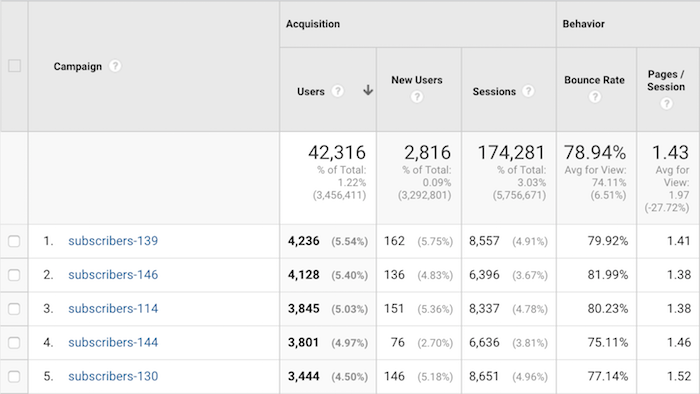
As you can see from the screenshot above, I used Subscribers to get 42,316 people back to my site 174,281 times.
User signal #5: Percentage of search traffic from brand queries
I’ve blogged about this in the past and have even shown you how my search traffic started to climb as my brand queries grew.
Just as a quick recap, I found that as more people Googled “Neil Patel” or variations of it, Google started to rank my site for other terms like “online marketing.”
Once I learned that brand queries help, I spent more time on building a brand. Now during any given month, I generate roughly 40,412 visitors per month from brand related terms:
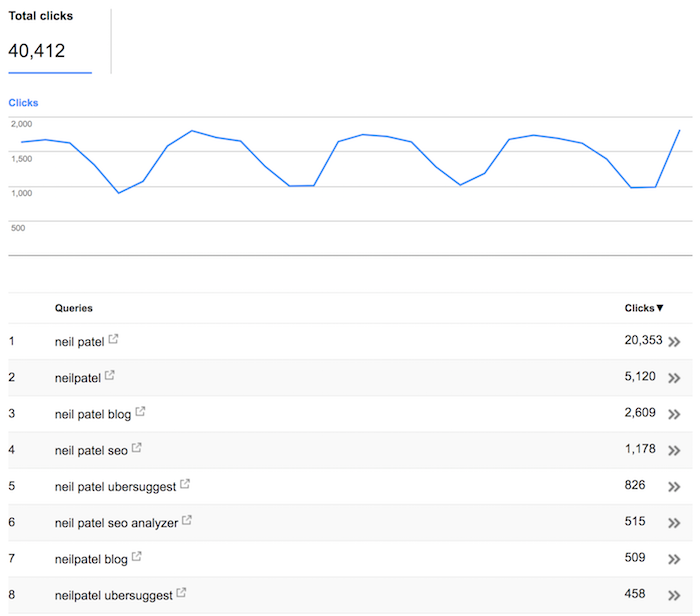
I even generate 3,806 brand queries on YouTube:
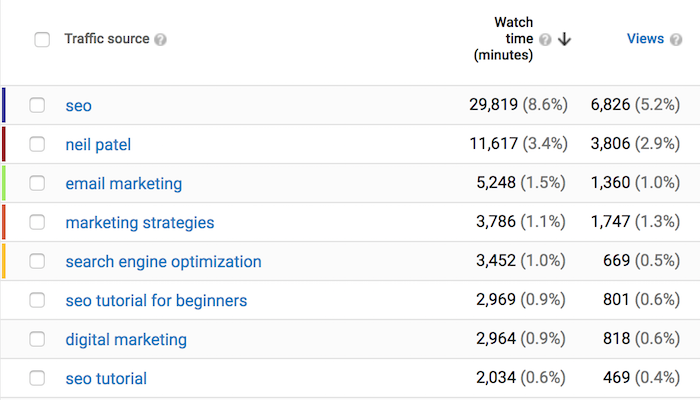
It’s not just me either. Sites that continually dominate Google also have brand queries as a portion of their search traffic.
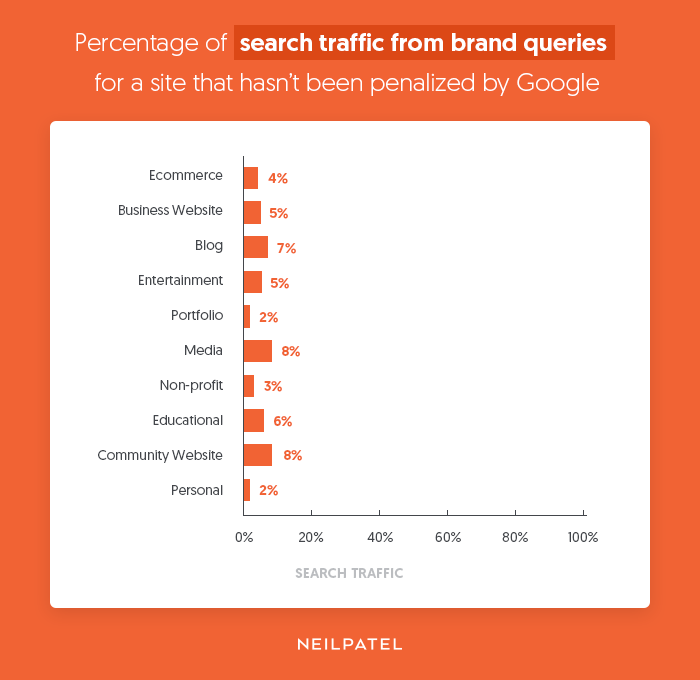
And these sites aren’t just getting people to search for their brand, but a high portion of those searches land back to their site. In other words, their brand queries have a high click-through rate.
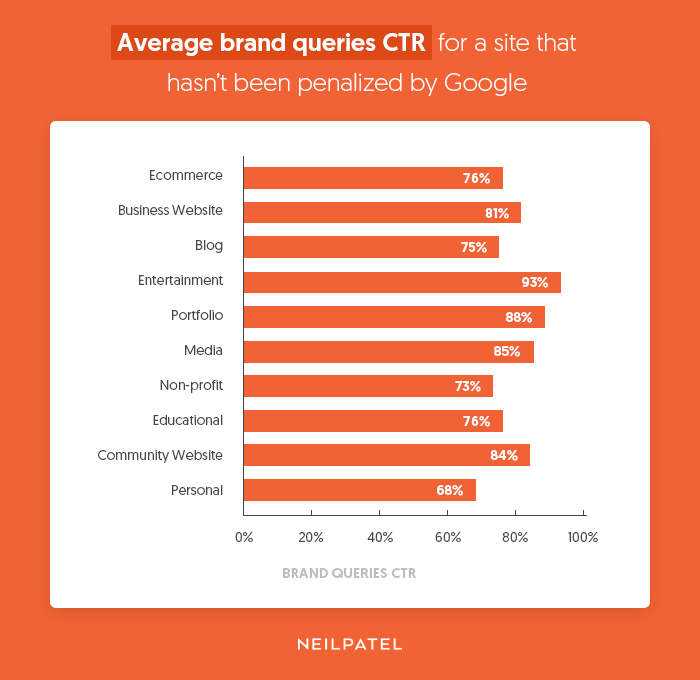
If you want to dominate Google, you need to build a brand.
The bigger your brand and the more loyal people are to it, the more search traffic you’ll get over time.
If you aren’t familiar with how to build a brand, check out hack number 3 in this article that I recently wrote.
User signal #6: Click-through rate
Speaking of click-through rate, we thought it would be interesting to analyze everyone’s Google Search Console to see the click-through rate these sites had.
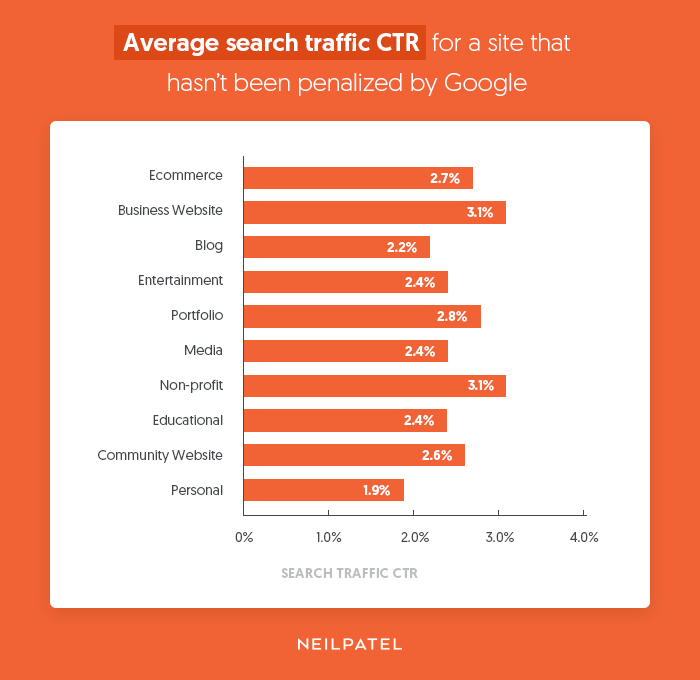
Most of these sites had click-through rates between 1.9% and 3.1%.
If your website has a low click-through rate, you can improve it by following these 13 steps.
My best advice is to continually A/B test your title and meta description tag to see if you can make it more appealing so that more people want to click on your search listing as opposed to your competitor’s.
User signal #7: Pageviews per visitor
If someone continually browses your site and visits many pages, you are usually doing something right because it means that people like your content, product, service, or whatever else you are offering.
Of course, you can game the system by writing a really long article and only putting a few hundred words on each page and make people click a “next” button to keep reading more.
But that’s a terrible user experience and you don’t want to do that.
You want people to naturally want to visit tons of pages on your website without having to trick them.
So how many pageviews per visitor do high ranking sites have? Well, here’s the average:
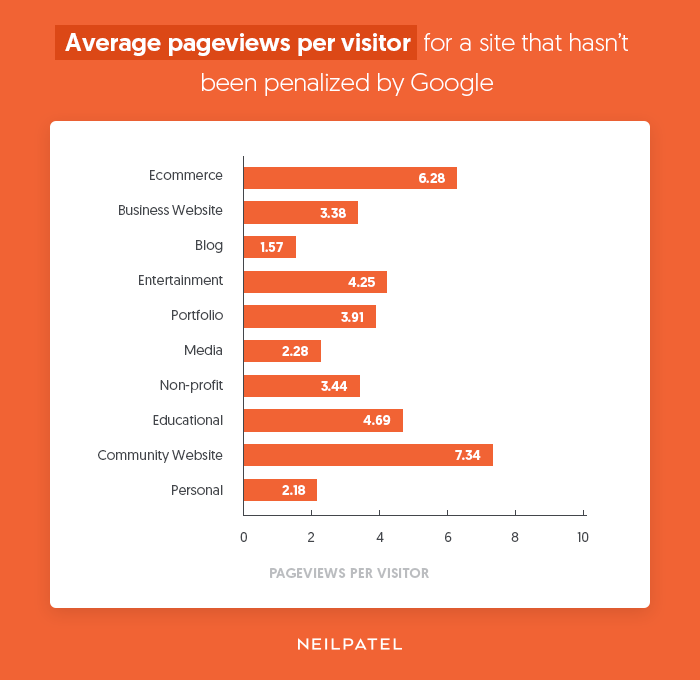
If you want to boost your pageviews per visitor, just follow the tips in this article.
User signal #8: Average time on site
You don’t want people to leave your site… unless they are going to buy something or click on ad.
You want them to stay on your site as long as possible.
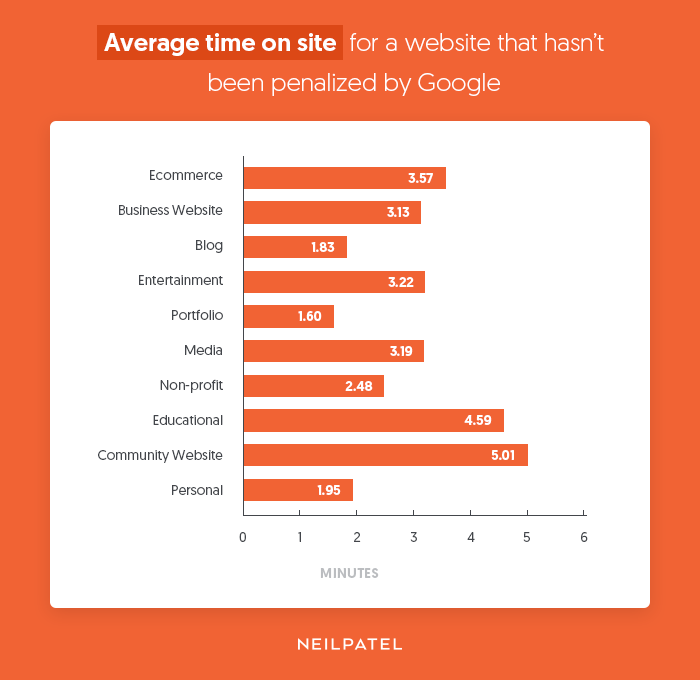
As you can see from the chart above, websites that ranked well on Google were able to keep people around for at least 1.6 minutes if not all the way up to 5 minutes.
Now the 5-minute number is going to be a bit tough, but if you can keep people on your site for over 2 minutes you are going to do well.
Plus, you’ll have fewer chances of getting hit by a Google Panda penalty.
This article will teach you how to keep people on your website longer (without tricking them).
Conclusion
To dominate Google, you need to think like Google. It’s not just about gaming the system and tweaking your site so that Google loves you.
It’s more about understanding their main objective, which is to put the user first.
That means that if you also put the user first, in the long run, your rankings should slowly climb.
Now, this doesn’t mean you can ignore normal SEO practices like on-page SEO and link building, but instead, you need to do all of that in parallel with focusing on the user.
So how do your metrics stack up with the benchmarks above?
The post What Do Sites That Have Never Been Penalized by Google Look Like? appeared first on Neil Patel.
from Blog – Neil Patel https://ift.tt/2x5lhPt

No comments:
Post a Comment